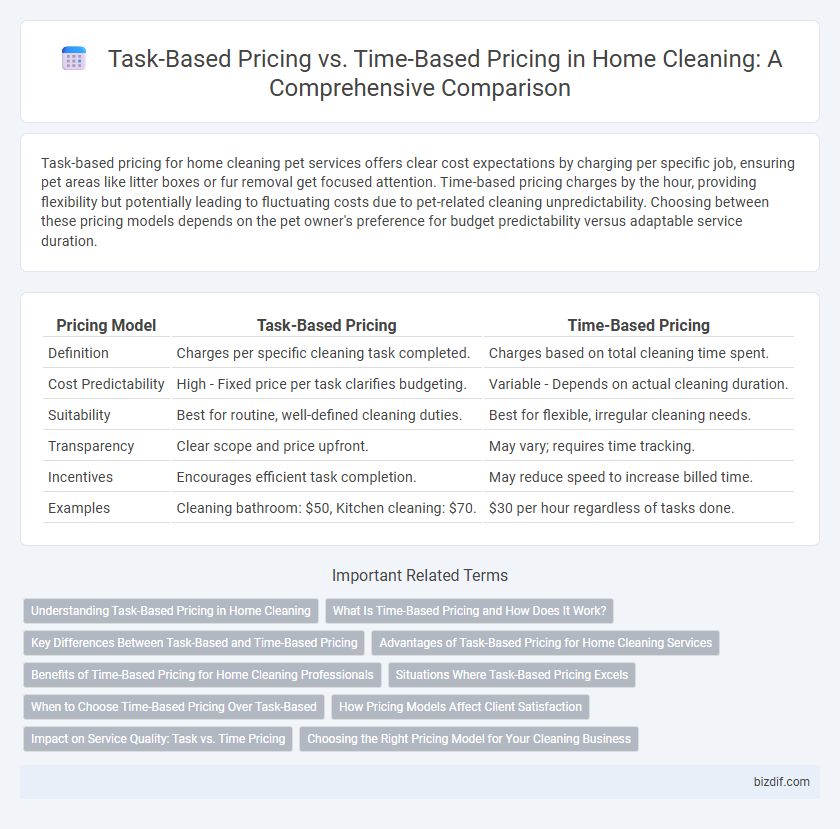Task-based pricing for home cleaning pet services offers clear cost expectations by charging per specific job, ensuring pet areas like litter boxes or fur removal get focused attention. Time-based pricing charges by the hour, providing flexibility but potentially leading to fluctuating costs due to pet-related cleaning unpredictability. Choosing between these pricing models depends on the pet owner's preference for budget predictability versus adaptable service duration.
Table of Comparison
| Pricing Model | Task-Based Pricing | Time-Based Pricing |
|---|---|---|
| Definition | Charges per specific cleaning task completed. | Charges based on total cleaning time spent. |
| Cost Predictability | High - Fixed price per task clarifies budgeting. | Variable - Depends on actual cleaning duration. |
| Suitability | Best for routine, well-defined cleaning duties. | Best for flexible, irregular cleaning needs. |
| Transparency | Clear scope and price upfront. | May vary; requires time tracking. |
| Incentives | Encourages efficient task completion. | May reduce speed to increase billed time. |
| Examples | Cleaning bathroom: $50, Kitchen cleaning: $70. | $30 per hour regardless of tasks done. |
Understanding Task-Based Pricing in Home Cleaning
Task-based pricing in home cleaning offers clients a clear, upfront cost by charging according to specific cleaning tasks rather than hours spent. This method enhances transparency and allows homeowners to select services like vacuuming, window washing, or deep kitchen cleaning individually. By focusing on task efficiency, cleaning companies can optimize resource allocation and deliver consistent results without the uncertainty of fluctuating time estimates.
What Is Time-Based Pricing and How Does It Work?
Time-based pricing in home cleaning charges clients according to the duration of the cleaning session, typically calculated hourly. This model allows flexibility for varying task complexities and accommodates unexpected additional work without upfront cost estimates. Clients benefit from transparent billing, paying only for the actual time professionals spend cleaning, which suits irregular or one-time cleaning needs.
Key Differences Between Task-Based and Time-Based Pricing
Task-based pricing in home cleaning charges clients a fixed rate per completed job, providing transparency and budget predictability, while time-based pricing bills customers based on hourly rates, allowing flexibility for variable cleaning durations. Task-based models are ideal for straightforward, consistent cleaning tasks, whereas time-based pricing suits customized or deep cleaning sessions that may require more time. Understanding these differences helps homeowners select pricing structures aligned with their cleaning needs and financial preferences.
Advantages of Task-Based Pricing for Home Cleaning Services
Task-based pricing in home cleaning services ensures transparent and predictable costs tailored to specific cleaning tasks, enhancing customer trust and satisfaction. It allows for precise budgeting by charging fixed rates for defined services such as deep cleaning, carpet cleaning, or window washing, reducing the risk of unexpected expenses. This pricing model incentivizes efficiency among cleaners, potentially improving service quality and turnaround times compared to time-based billing.
Benefits of Time-Based Pricing for Home Cleaning Professionals
Time-based pricing allows home cleaning professionals to maximize earnings by charging for the actual duration of services, ensuring fair compensation for complex or unexpected tasks. It promotes transparency with clients, as the cost directly reflects the time invested, fostering trust and repeat business. This pricing model also offers flexibility to accommodate varying home sizes and client needs without the constraints of fixed task rates.
Situations Where Task-Based Pricing Excels
Task-based pricing proves highly effective for home cleaning jobs with clearly defined scopes, such as deep-cleaning a kitchen or sanitation of bathrooms. This method offers cost transparency, enabling customers to pay a fixed rate for specific cleaning tasks rather than uncertain hourly charges. Task-based pricing excels in repetitive or specialized cleaning services where outcomes and expectations can be easily measured upfront.
When to Choose Time-Based Pricing Over Task-Based
Time-based pricing is advantageous for home cleaning tasks with unpredictable durations or varying complexities, such as deep cleaning or post-renovation cleanup. Opting for time-based rates ensures fair compensation when tasks require flexible attention or adapt to client-specific needs. This method is ideal when the scope of work cannot be precisely estimated in advance, offering transparency for both cleaners and clients.
How Pricing Models Affect Client Satisfaction
Task-based pricing offers clients clear expectations and often leads to higher satisfaction by ensuring they pay only for specific services completed. Time-based pricing can create uncertainty, sometimes causing clients to feel overcharged if tasks take longer than anticipated. Transparent communication and selecting the appropriate pricing model aligned with client preferences significantly enhance overall satisfaction in home cleaning services.
Impact on Service Quality: Task vs. Time Pricing
Task-based pricing in home cleaning ensures service quality by focusing on the thorough completion of specific cleaning tasks, leading to consistent and measurable results. Time-based pricing may compromise quality as cleaners might rush or extend service duration without necessarily improving outcomes. Prioritizing task pricing aligns cleaner incentives with customer satisfaction, enhancing overall service effectiveness and reliability.
Choosing the Right Pricing Model for Your Cleaning Business
Task-based pricing in home cleaning sets fixed rates for specific services, ensuring transparent costs and client satisfaction. Time-based pricing charges by the hour, offering flexibility for unpredictable cleaning needs and varying home sizes. Selecting the right model depends on client preferences, job complexity, and operational efficiency to maximize profitability and market competitiveness.
Task-Based Pricing vs Time-Based Pricing Infographic

 bizdif.com
bizdif.com